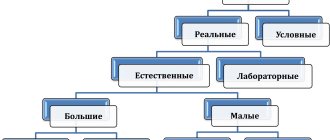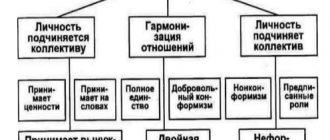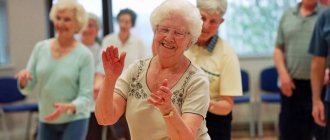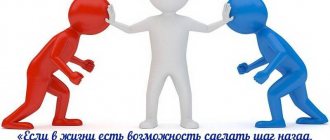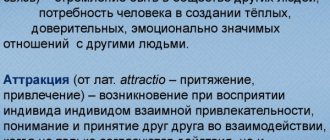Psychological characteristics of groups (page 1 of 3)
1. GENERAL CHARACTERISTICS OF GROUPS.
2 1.1. Approaches to defining the concept. 2
1.2. Types of groups. 3
2. FACTORS FOR FORMING GROUPS IN AN ORGANIZATION. STAGES OF GROUPS DEVELOPMENT. 5
3. RELATIONSHIP OF “INDIVIDUAL” AND “GROUP” IN ORGANIZATIONAL MANAGEMENT. 10
LIST OF REFERENCES USED. 14
1.
GENERAL CHARACTERISTICS OF GROUPS
1.1.
Approaches to defining the concept
.
Psychology's attention to the laws of formation of social groups has caused life. As always happens, in the case of the existence of a social order on the part of society, this problem began to be quickly investigated. What exactly aroused public interest? As almost always happens - war. The first attempts to find out what the cohesion of a team depends on were made at the beginning of the First World War. The Second World War gave the greatest impetus to the study of this problem. The immediate reason was the arming of the US Air Force with heavy bombers B-17 and B-24. The crews of these “flying fortresses” consisted of 10-12 people. But then it turned out that pilots, navigators, and air gunners with the same level of military training behaved very differently during missions, namely: some always carried out tasks, others - half the time, others - never. This is not about cowardice. It turned out that in the first case a single team was formed, in the second, several groups acted as part of the crew, in the third - everyone was for himself. It was the need to staff combat aircraft with psychologically compatible people that initiated the development of research in the field of psychology of small groups.
A group is a collection of people who stand out from society due to the presence of certain characteristics (common profession, preferences, views
).
Until recently, Western psychology did not recognize the concept of “collective” and operated with the concept of “small social group”. In recent years, both in foreign and domestic psychology, and accordingly in management, the existence of both a social group and a team has been recognized.
In social psychology, the group is the center in which individual interests, needs and goals of the individual are satisfied, connections, social and psychological determinants of the regulation of his behavior intersect.
A group is a specific community of people involved in their typical types and forms of activity and united by a system of relationships.
The behavior and activities of people in groups are regulated by common goals, norms, and values. The main characteristics of the group:
— content and nature of joint activities;
- goals and objectives of joint activities - a certain type of relationship between individuals in the group;
— external and internal organization;
— norms and values accepted in the group;
- awareness by individuals belonging to the group of their involvement in it, the presence of a “we-feeling”;
— presence of group attributes (name, symbols, etc.).
The generally accepted classification of groups by status is:
Formal - a group that has a composition recorded in official documents (team, crew, department). An informal group is a group of people united by tastes, norms of behavior, and interests. Typical example: music and sports fans, neighborhood teenage groups.
By the nature of interaction
groups are distinguished:
In contact (real) groups, interaction occurs directly between group members. In conditional groups, interaction between group members occurs indirectly (through newspapers, letters, appearances on radio and television).
The group has the following general patterns: 1) the group will inevitably become structured; 2) the group develops (progress or regression, but dynamic processes occur in the group); 3) fluctuation, a change in a person’s place in a group can occur repeatedly.
According to psychological characteristics
distinguish:
- reference groups
(standard), the norms and rules of which serve as a model for the individual.
Reference groups can be real or imaginary, but they always act as a source of norms or rules that a person wants to join.
It is possible to classify groups in terms of the specifics of information dissemination
and organizing interaction between group members. So, they distinguish:
1. pyramidal
group ,
which is:
a) closed type system;
b) built hierarchically, i.e. the higher the place, the higher the rights and influence;
c) information flows mainly vertically, from bottom to top (reports) and top to bottom (orders);
d) every person knows his “hard” place;
e) traditions are valued in the group;
f) the leader of this group must take care of his subordinates, in return they obey unquestioningly;
g) such groups are found in the army, in established production, as well as in extreme situations;
Classification of associations by composition, features, forms of relations
Groups are divided into conditional (identified by researchers based on a common characteristic) and real (existing as a community). Real groups are divided by the nature and characteristics of interaction
- Nominal - organized spontaneously, exists temporarily. Members of the community do not develop close relationships; their main interest is performing certain activities. Such communities include tourists, spectators, and public transport passengers.
- Association is a union that includes only individuals united by common goals (union of friends). As a rule, they are stable, leadership is democratic in nature.
- Cooperation is a stable community with clear goals. The level of cooperation is high, the relationship is businesslike, and the hierarchy is strictly observed. Thanks to this, high performance in the chosen type of activity is achieved.
- Corporation - unites around internal goals, ignoring external ones. Acts as an asocial association, not inclined to cooperate with other communities.
As a rule, the format of group relations is determined before the formal unification of the community. But accidentally entering a community with a strong leader with interests that contradict the original ones can change the internal foundations and direction of the community.
Preview:
Psychological and pedagogical characteristics of the group.
The number of first-year students of the Faculty of Mathematics of group 2.2 is eight people. Of these, two are boys and six are girls. The students are seventeen to eighteen years old. The guys don’t know each other for long, as they’ve been studying together for one month, and besides, they all came from different cities. Therefore, established traditions are still weakly expressed in the group.
The group is quite active and full of creative energy. Positive spiritual needs and the desire to study prevail. All group members strive to cooperate and help each other. At the same time, some people have a need for self-affirmation and self-realization, a desire to stand out. The most respected are collectivists who do everything for the sake of the group, such as the headman.
Most of the students in the group live in a dormitory, which brings them closer together; they strive to constantly communicate with each other, and also maintain friendly relations with students from other groups.
The group has a fair attitude towards all members, a desire to support the weak in common activities, and a sense of security for everyone.
The group has self-government bodies represented by the headman, who maintains contact with the dean’s office of the Faculty of Mathematics and informs all members of the group about the requirements of the dean’s office. The headman is active, easily gets along with people, and does not experience difficulties in communication. Also, all members of the group help and support the headman. He enjoys the trust and authority of his classmates.
Students can choose their own representatives for various types of activities, for example, trade union activities, organizing holidays: “Freshman”, etc.
The group is friendly towards new members and tries to help them get comfortable.
Students easily, freely, quickly, and with high efficiency coordinate their actions. The existing individual groups actively interact with each other, maintaining group unity.
Capable group organizers are its authoritative and authorized representatives. The group knows how to regulate and control their emotional states. The guys like to be together and participate in joint activities.
Students are interested in their future profession. No one regrets their choice; everyone is very glad that they are studying at the Faculty of Mathematics at VSU. When asked, “Which faculty would you like to enroll in now?”, everyone answered that they would again choose the Faculty of Mathematics.
To identify the structure of interpersonal relationships in the group, based on sympathy and emotional connections, I conducted a sociometric study.
First question: who would you go with to City Day?
The process of group formation: stages of development and distribution of roles
The formation of a community occurs in 3 stages:
- Formation and initial unity. Individuals get acquainted, primary recognition of each other occurs. There is a high level of emotional tension, which disappears as acquaintance deepens. Group members learn rules of behavior and form a sense of belonging. At this stage, one or more leaders are identified.
- The emergence of contradictions and conflicts. There is a conflict of interests between small unions and individualists trying to assert their place in the team. The struggle for leadership leads to contradictions, quarrels and division.
- Constructive cooperation. The level of psychological unity increases. The group acquires status in society and approaches the status of a collective. The emotional atmosphere levels out and becomes friendly.
The process of an individual’s entry into a team occurs in 3 phases:
- Adaptation. The personality learns the rules of behavior, and is still constrained in the manifestations of individual qualities.
- Personalization. The personality declares itself in order to take the most advantageous place in the hierarchy.
- Integration. The team determines the newcomer’s place by assessing his personal qualities.
The following roles are distinguished in the group according to the level of authority:
- leader;
- popular;
- preferred;
- ignored;
- outsiders.
The higher the status of an individual, the more power he enjoys. In the process of development of a team, individuals can challenge the assigned status, moving to the top level of the hierarchy. If the rules of behavior in the group are neglected, the individual who initially occupied a high position may move down.
General information
The team (student group 12-P) was formed in 2007. The group is fairly homogeneous in terms of age. The age difference is no more than 1-2 years. All have incomplete secondary school education. This team consists of 9 girls and 12 boys. The tradition of the team, like all students, is to celebrate “Student’s Day”.
The group's performance is above average and it is the best performing group of the remaining groups. The group is academically disciplined, weaker students try to keep up with the rest. Those who are lagging behind are helped by more successful students, which characterizes the cohesion of the group. Group members are not limited to communication only within their own group, but also communicate with other classmates.
The predominance of public interest over personal interest: the formation of a team
The team is a group with a high level of development. To achieve this stage of community, it is necessary to act consciously and follow the plan, obey the requirements of the leader.
The team is characterized by:
- unity of motives and goals aimed at mutual assistance and support;
- conditions for personal development;
- group nature of the activity;
- voluntary and positive interaction;
- joint development of ways to achieve the goal.
To become a collective, a community must go through the following stages of development:
- The moment of occurrence.
- Naming.
- Emotional integration.
- Unity of purpose.
- Integration of goals into general social ones.
At the last stage, the interests of individuals become focused on a global goal and move to the stage of a pseudo-collective, for which personal goals are more important than public ones.
Productive communication within a team occurs due to the process of perceiving a person by a person - the formation of an image that arises during direct communication.
Perceptual mechanisms that enable interpersonal communication include:
- Identification is likeness to another individual, a primitive form of attachment. The object of identification can be either a real person or a fictional character.
- Empathy is penetration into a person’s emotional state, sharing his feelings.
- Reflection is an assessment of one’s own mental state, analysis of the impression made on team members.
- Attraction is the formation of attachment based on the attractiveness of one individual to another.
In a developed team, an individual works for public interests, but gets the opportunity to develop his strengths. The team works as a well-coordinated team, directing its main aspirations towards universal human interests.

